Mantegna, Marcantonio and Parmigianino
8 July 2016 – 22 January 2017
Hunterian Art Gallery
Admission free
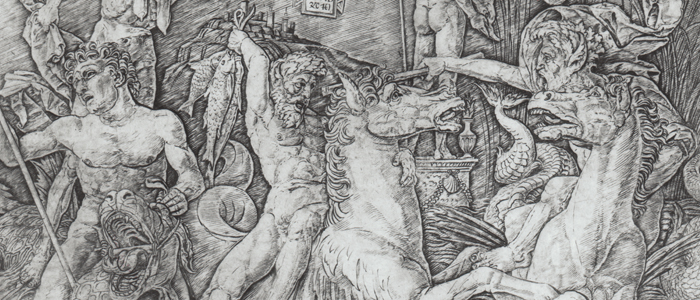
Introduction
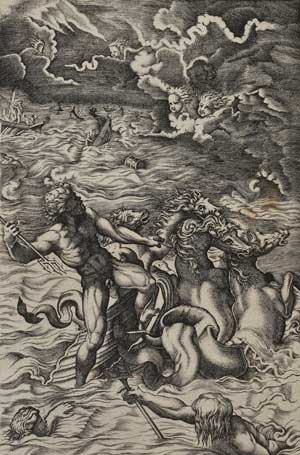 The Hunterian has an exceptional collection of engravings by Italian Renaissance artists. This exhibition focuses on the production of three major figures: Andrea Mantegna, Marcantonio Raimondi and Parmigianino.
The Hunterian has an exceptional collection of engravings by Italian Renaissance artists. This exhibition focuses on the production of three major figures: Andrea Mantegna, Marcantonio Raimondi and Parmigianino.
Through examples of some of their finest prints we can follow the changes that took place in the way artists made and used prints in the period 1460-1540.
In late 15th century, printing technology spread from Germany to Italy and the graphic arts flourished, partly due to the stimulus given to the manufacture of paper by book printers. Prints of all kinds were produced and at every price.
Prints provided painters’ workshops with extra income and at the same time, forward looking artists acquired well designed prints as illustrations of figures or statues or as reminders of the work of successful painters.
Those on display in this exhibition were made by some of the most important artists of the Renaissance and were immediately treasured by artists and collectors alike.
Marcantonio
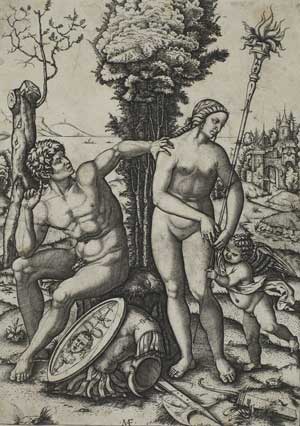 Marcantonio Raimondi, also known simply as Marcantonio (c. 1480 – c. 1534), was an Italian engraver, known for being the first important printmaker whose body of work consists mainly of prints copying paintings. Considered a key figure in the rise of the reproductive print, he also set out a technique of engraving that became dominant in Italy and elsewhere.
Marcantonio Raimondi, also known simply as Marcantonio (c. 1480 – c. 1534), was an Italian engraver, known for being the first important printmaker whose body of work consists mainly of prints copying paintings. Considered a key figure in the rise of the reproductive print, he also set out a technique of engraving that became dominant in Italy and elsewhere.
1505 is the earliest date that appears on Marcantonio’s prints. In 1506 he was in Venice where he produced a set of prints of the Life of the Virgin, meticulously copied from Dürer and by 1510 he had settled in Rome. In this original work both technique and design follow Dürer closely. Not only was he aware of the best models in printmaking, but before he arrived in Rome he was familiar with the canon of ancient sculpture. Mars is based on the Belvedere Torso, which Michelangelo proposed as an ideal model for a heroic figure, referring to it as his ‘studium’ (Latin for study).
Mantegna
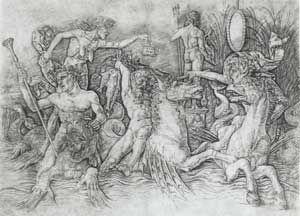 Andrea Mantegna (c. 1431 – 1506) was an Italian painter, a student of Roman archaeology and son-in-law of Jacopo Bellini – one of the founders of the Renaissance style. Like other artists of the time, Mantegna experimented with perspective and his landscapes and figures give evidence of a fundamentally sculptural approach to painting. He also led a workshop that was the leading producer of prints in Venice before 1500.
Andrea Mantegna (c. 1431 – 1506) was an Italian painter, a student of Roman archaeology and son-in-law of Jacopo Bellini – one of the founders of the Renaissance style. Like other artists of the time, Mantegna experimented with perspective and his landscapes and figures give evidence of a fundamentally sculptural approach to painting. He also led a workshop that was the leading producer of prints in Venice before 1500.
Mantegna was steeped in knowledge of ancient art. From 1460 he was employed in Mantua by the Gonzagas, who had important collections of ancient sculpture, images of which he incorporated in paintings and prints. This is half of a large two-sheet allegory of Envy, a subject inspired by the theorist Leon Batista Alberti’s challenge to represent abstract ideas that had been treated by ancient artists such as Apelles.
Parmigianino
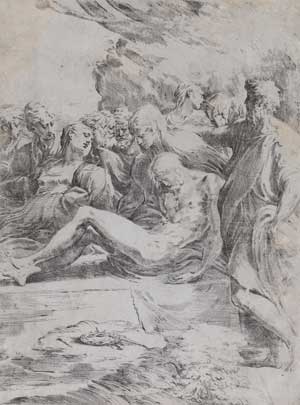 Girolamo Francesco Maria Mazzola (1503 – 1540), also known as Francesco Mazzola or more commonly, Parmigianino (the little one from Parma) was an Italian Mannerist painter and printmaker. His prodigious and individual talent has always been recognised, but his career was disrupted by war and then ended by his death at only 37. He produced outstanding drawings, and was one of the first Italian painters to experiment with printmaking himself.
Girolamo Francesco Maria Mazzola (1503 – 1540), also known as Francesco Mazzola or more commonly, Parmigianino (the little one from Parma) was an Italian Mannerist painter and printmaker. His prodigious and individual talent has always been recognised, but his career was disrupted by war and then ended by his death at only 37. He produced outstanding drawings, and was one of the first Italian painters to experiment with printmaking himself.
Parmigianino made two closely related etchings of this subject. This one, the earlier of the two plates, was spoilt after only a few impressions and the artist went on to produce the other with the image reversed and modified. (A careful oil sketch reveals the careful planning of these important prints). The lightness with which this work is needled, without recourse to engraving, is innovative. As in Dürer’s Passion series prints, the burial takes place under the roots of a tree, suggestive of rebirth.
Acknowledgements
 This exhibition highlights our important collection of 175 prints by Marcantonio and others which have been conserved as part of a project generously funded by Museums Galleries Scotland’s Recognition Fund. These prints are now fully documented and accessible for the first time.
This exhibition highlights our important collection of 175 prints by Marcantonio and others which have been conserved as part of a project generously funded by Museums Galleries Scotland’s Recognition Fund. These prints are now fully documented and accessible for the first time.

